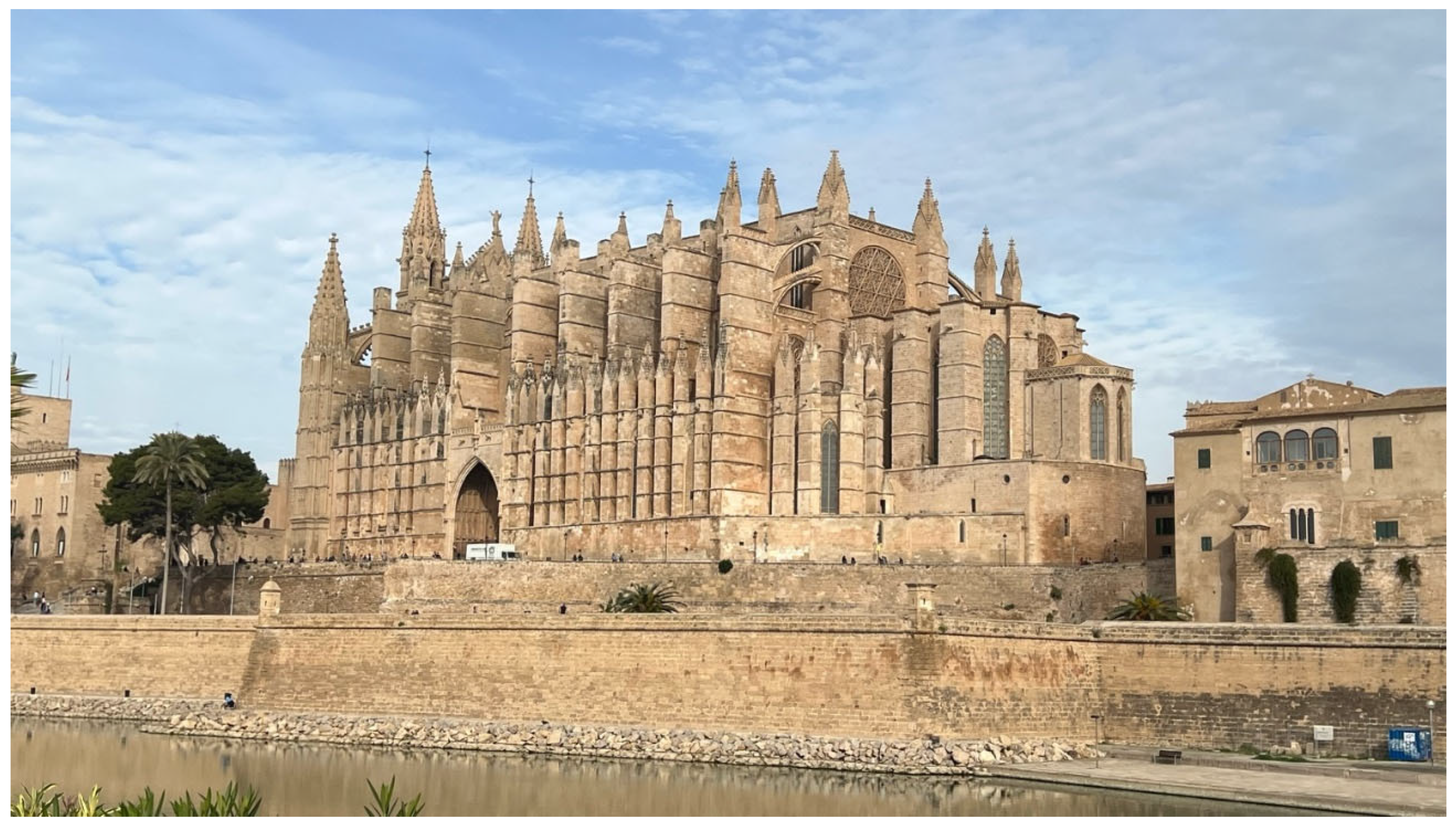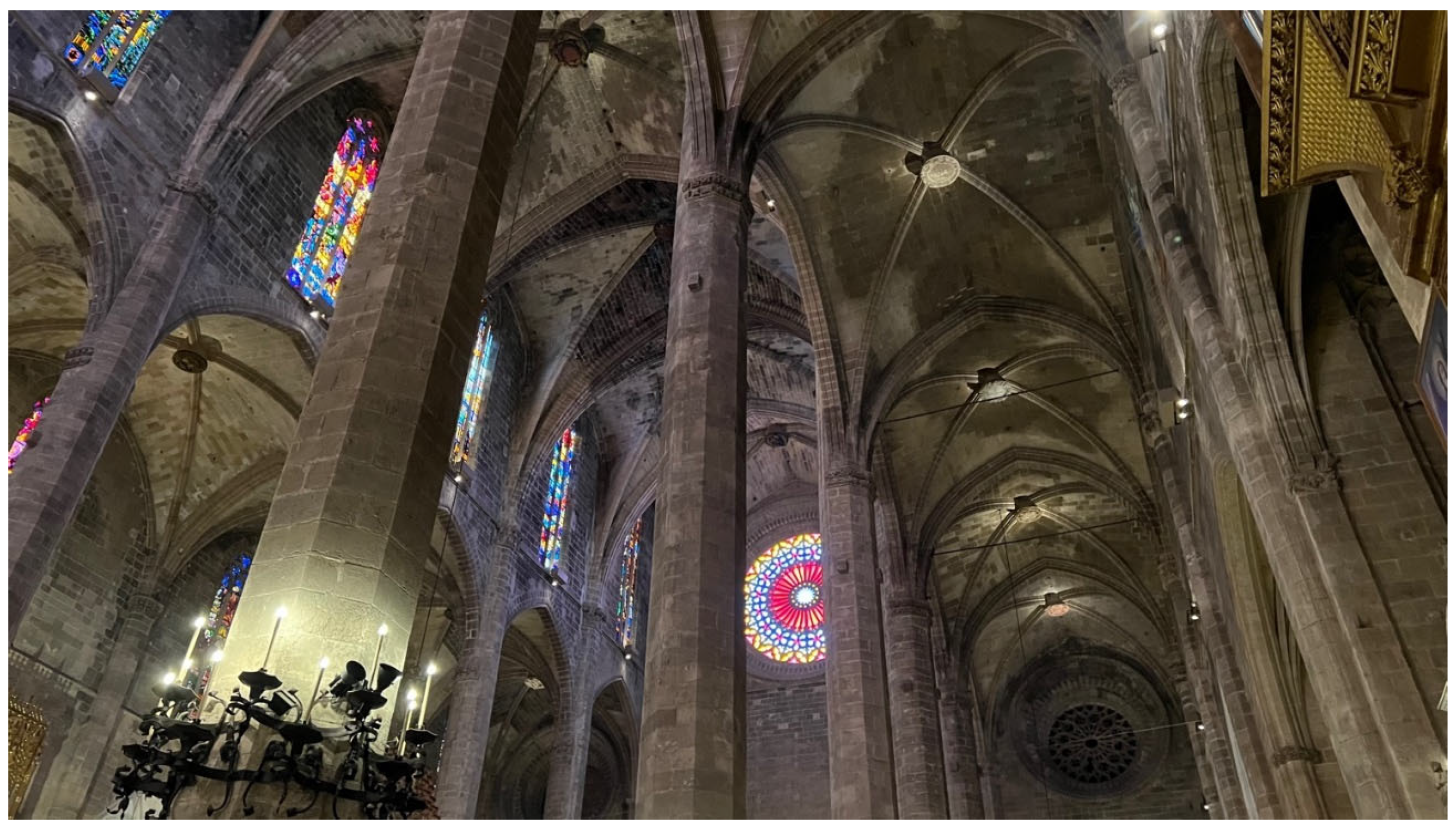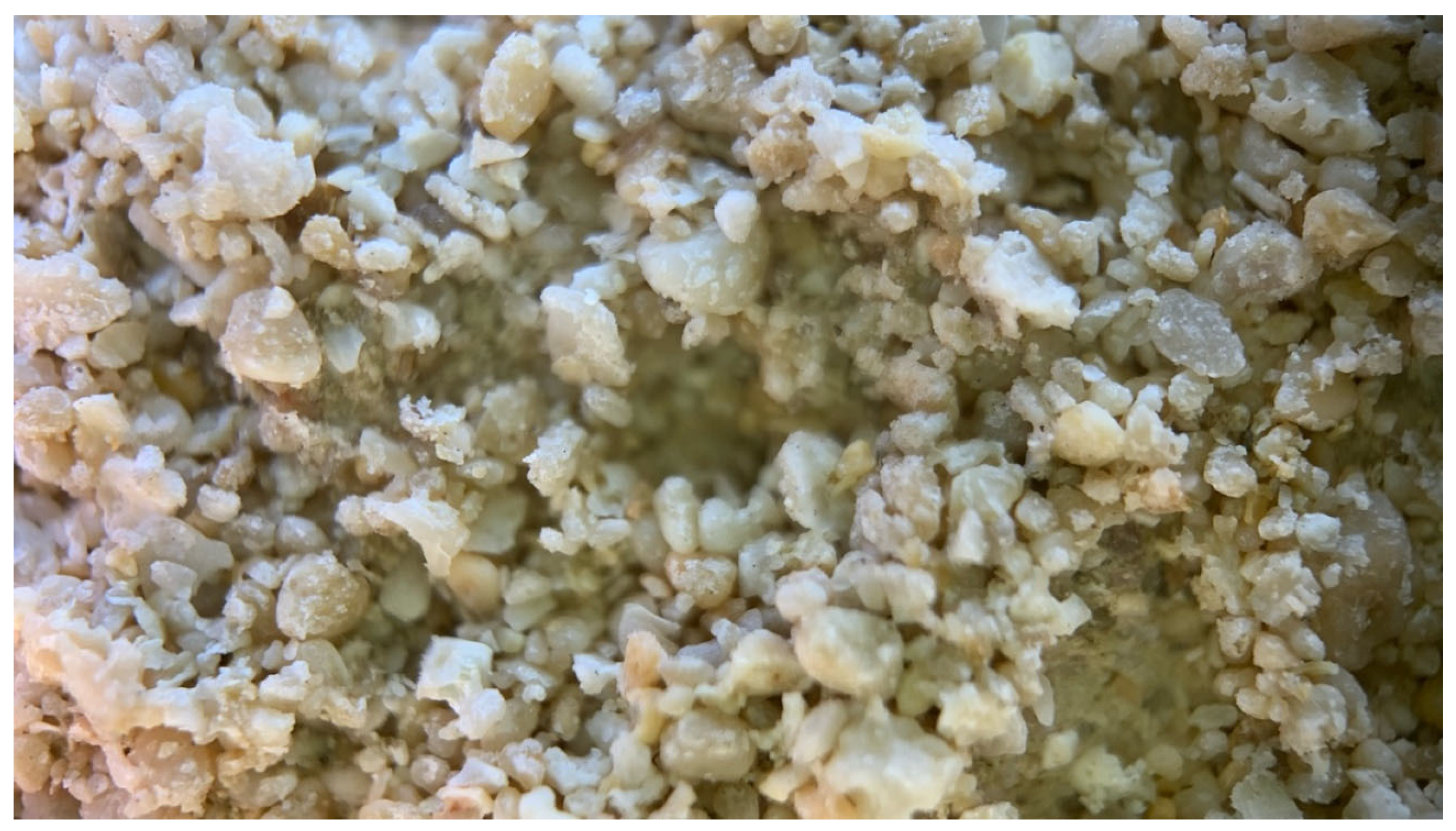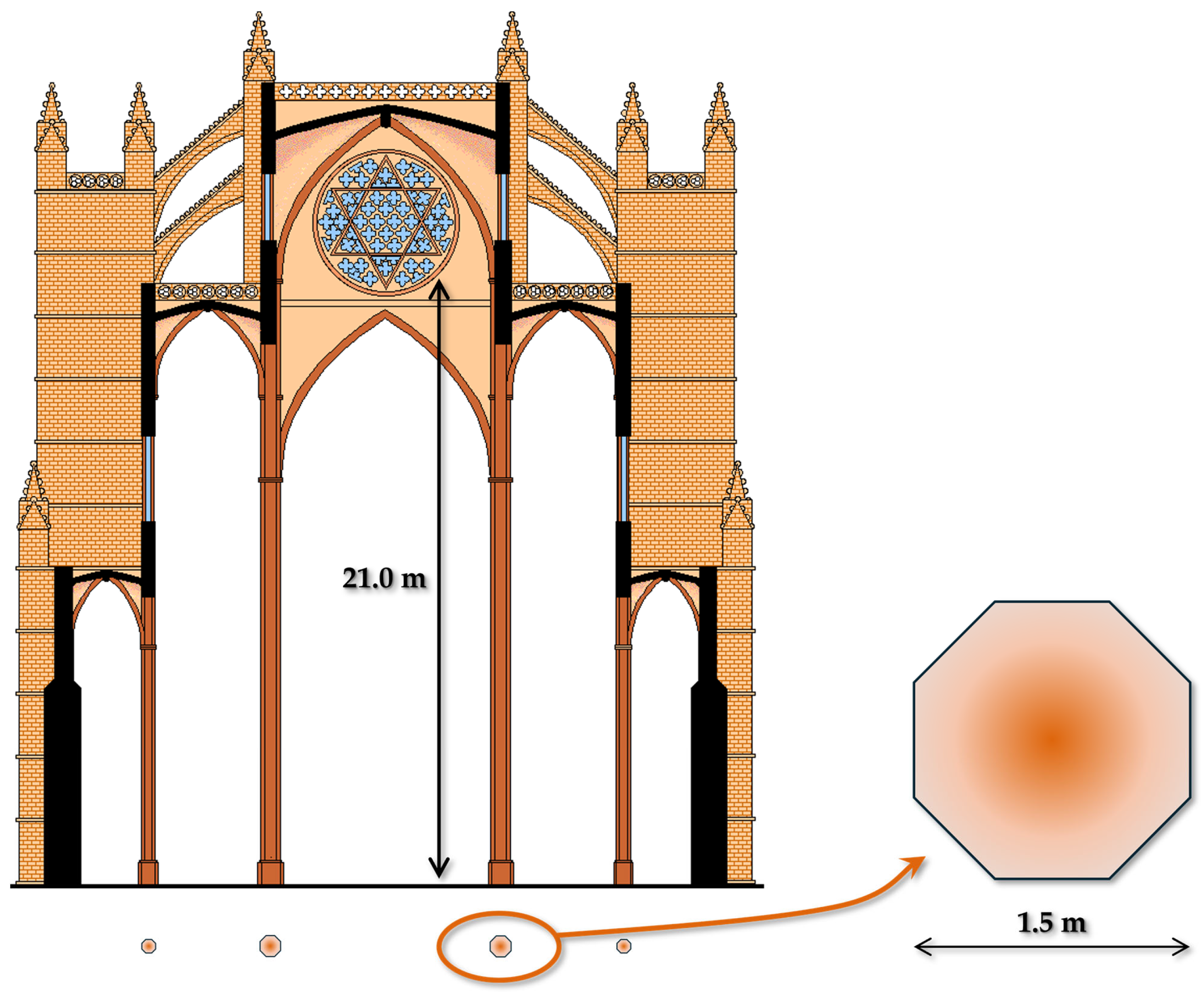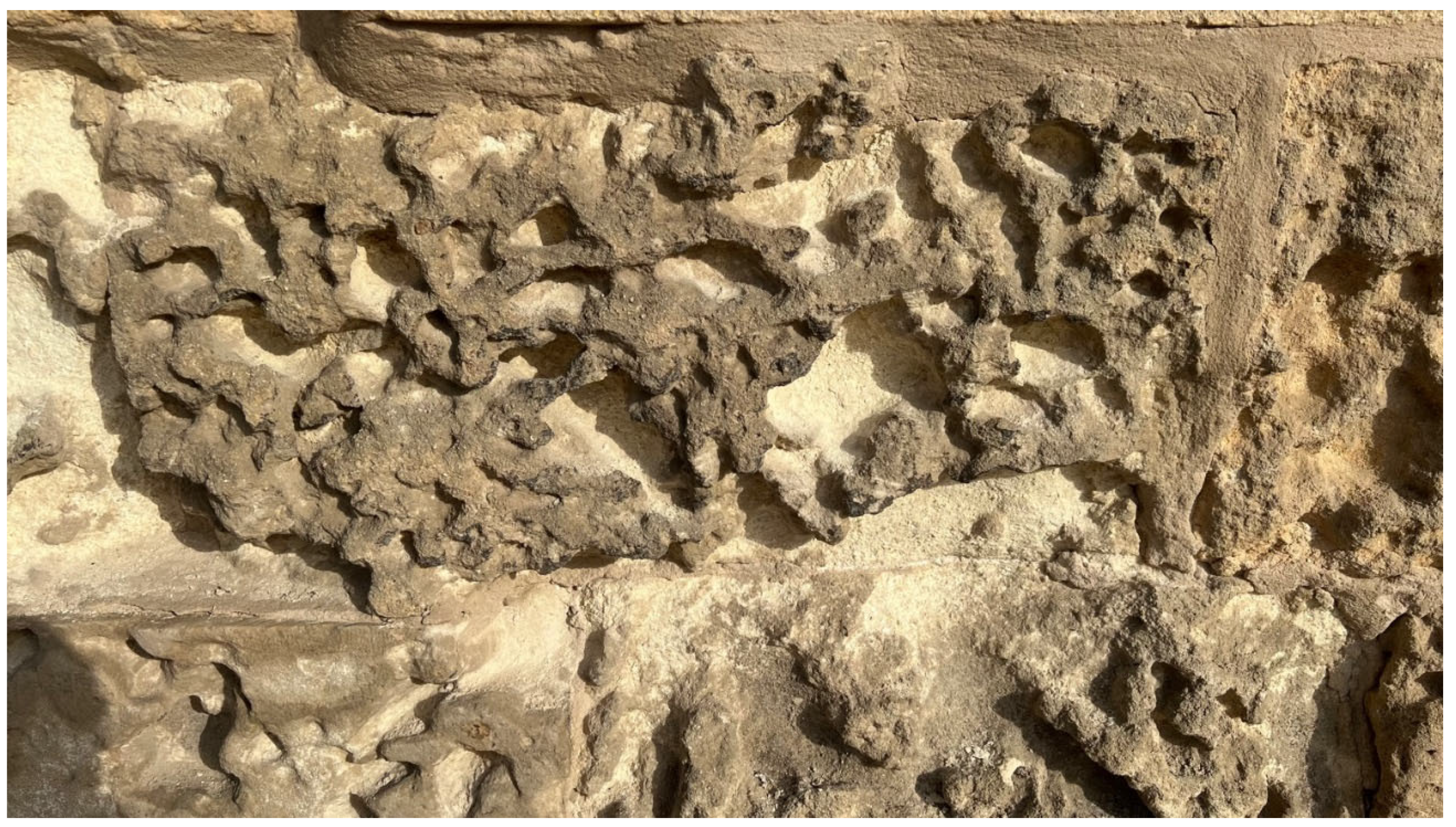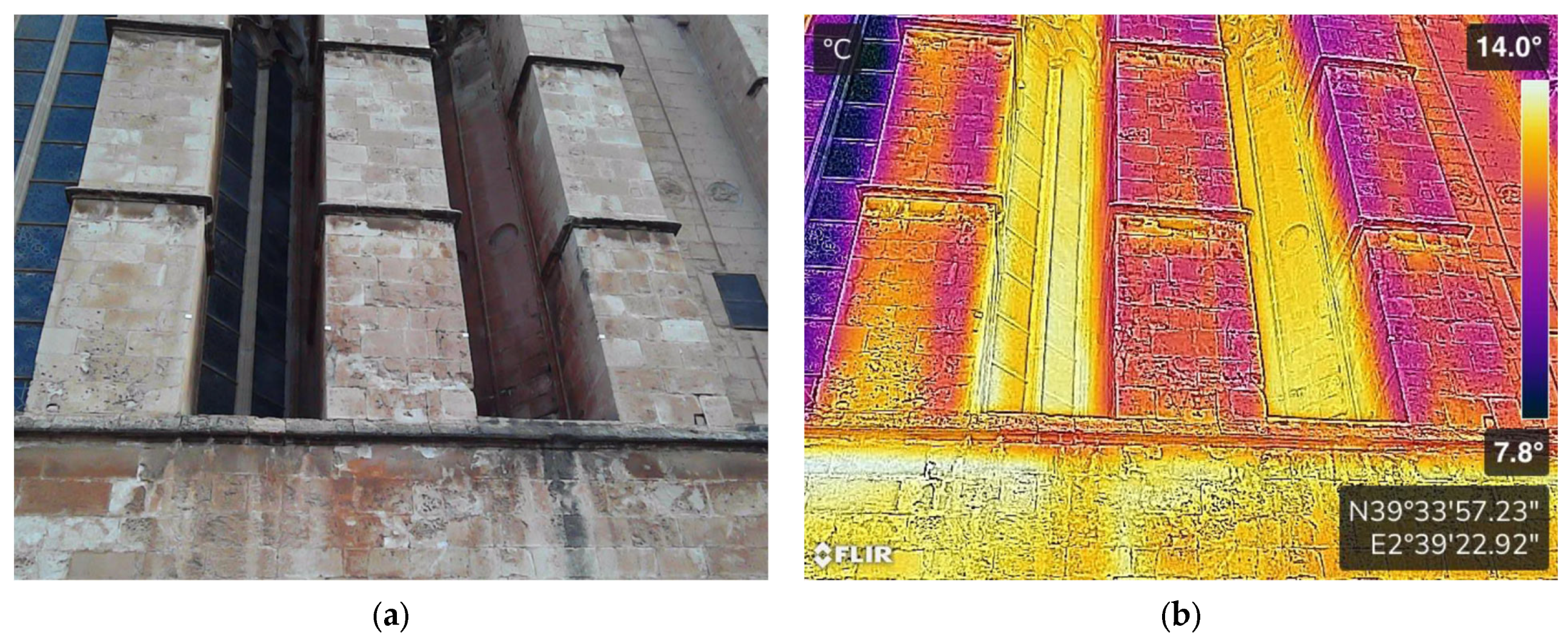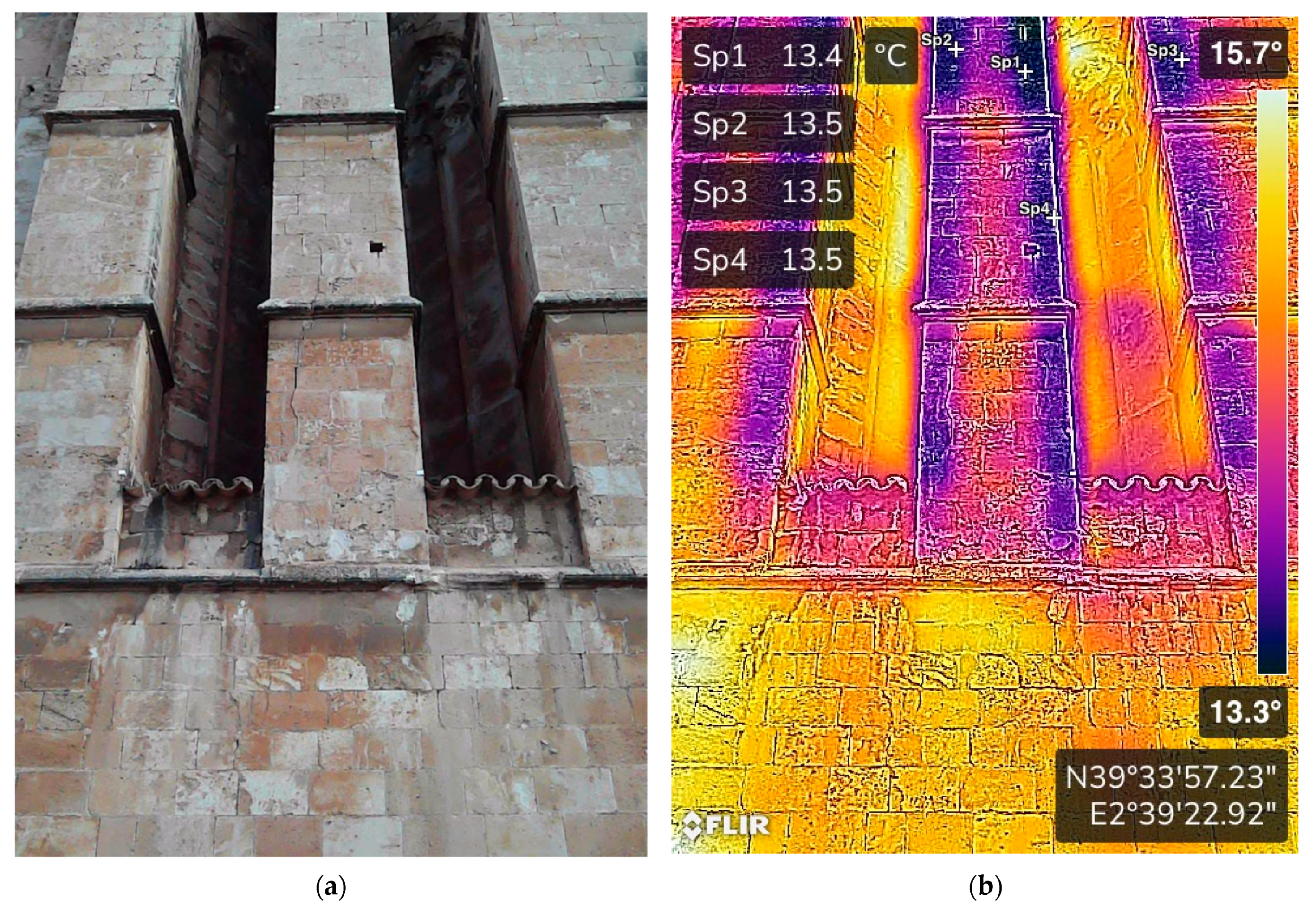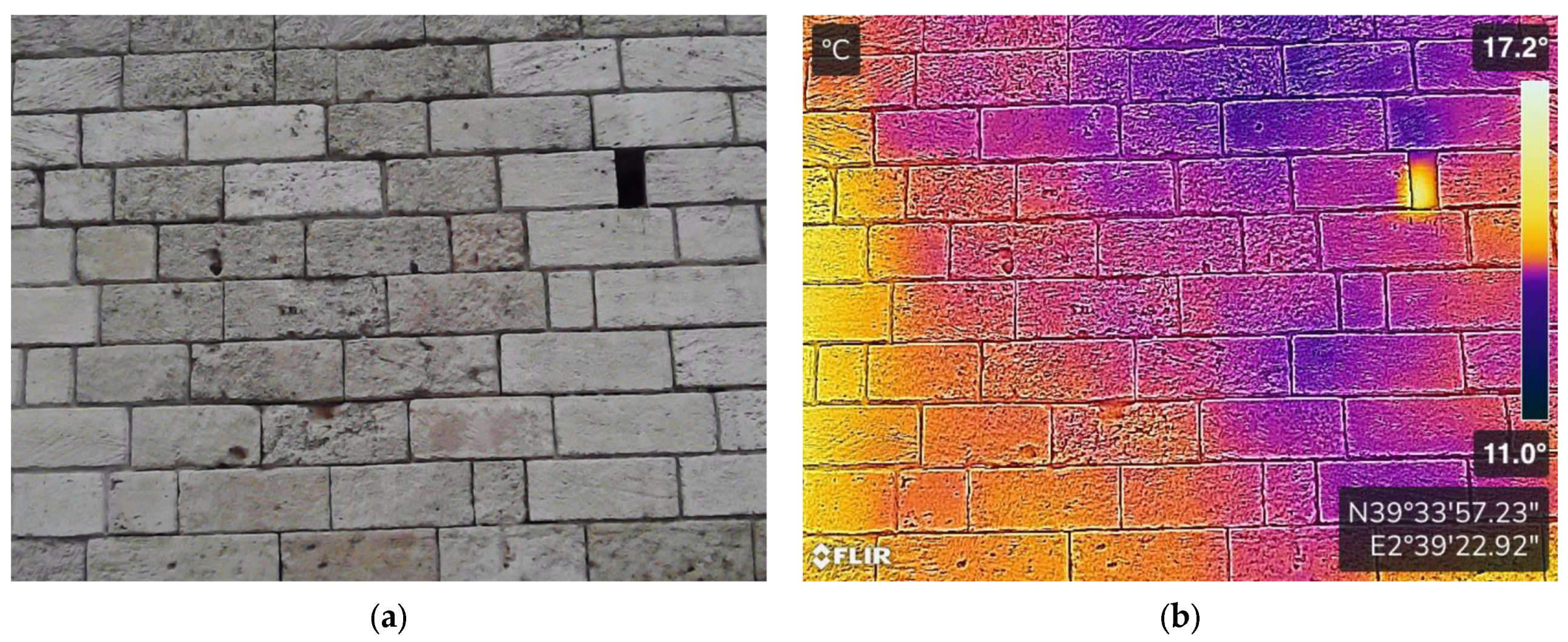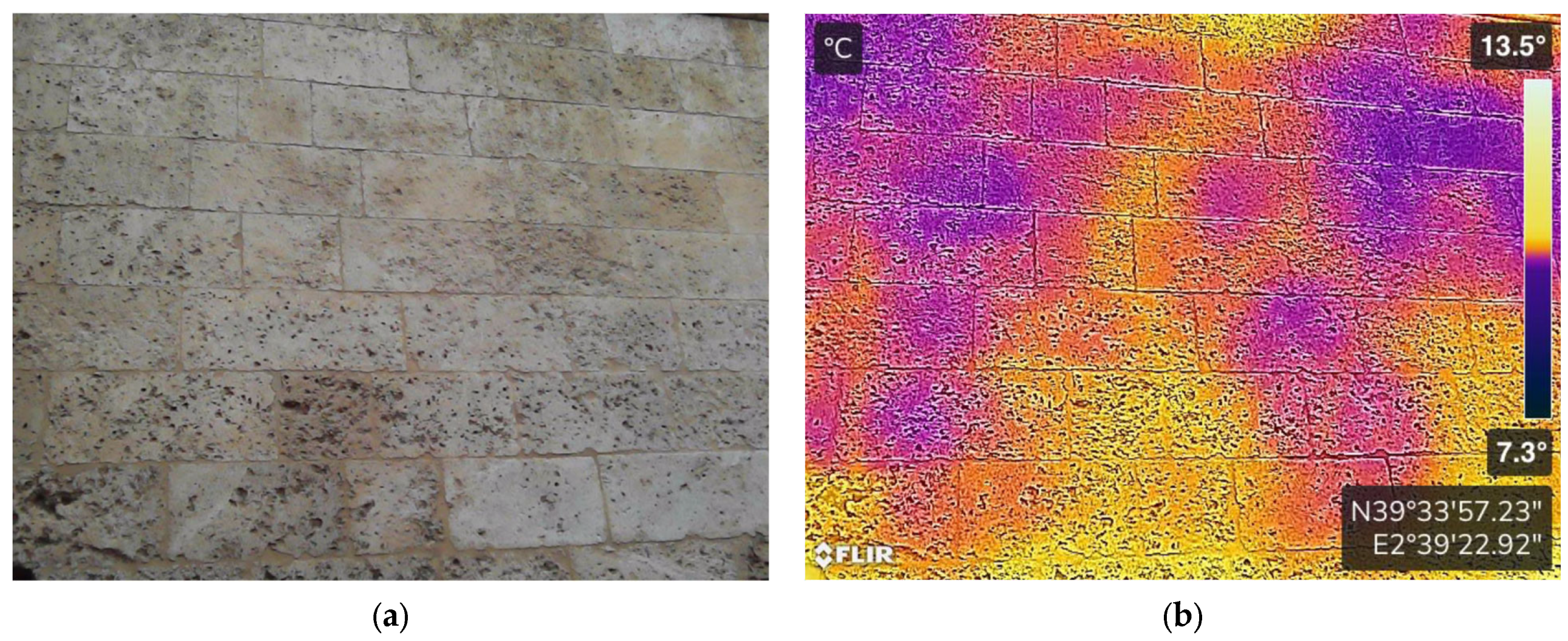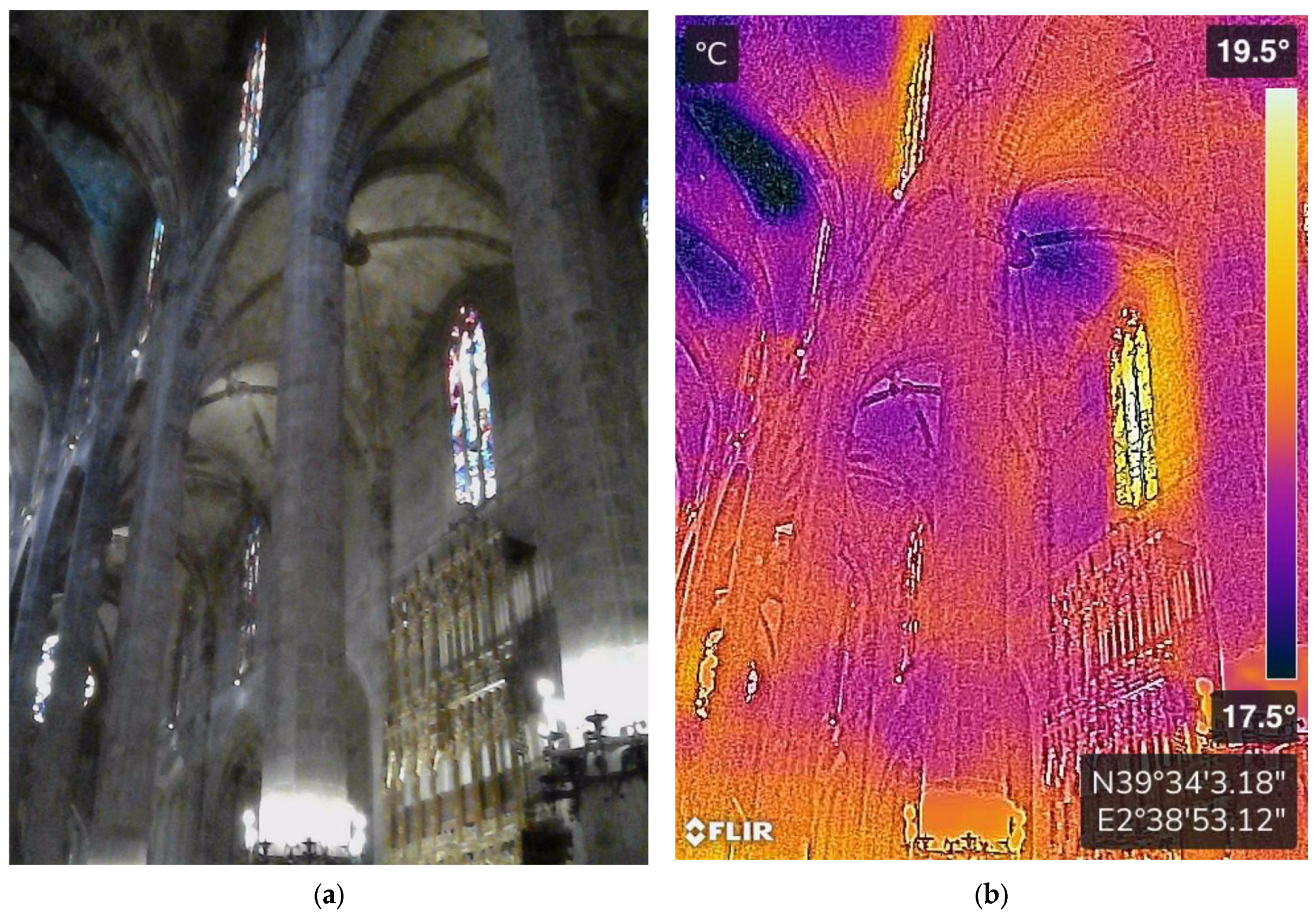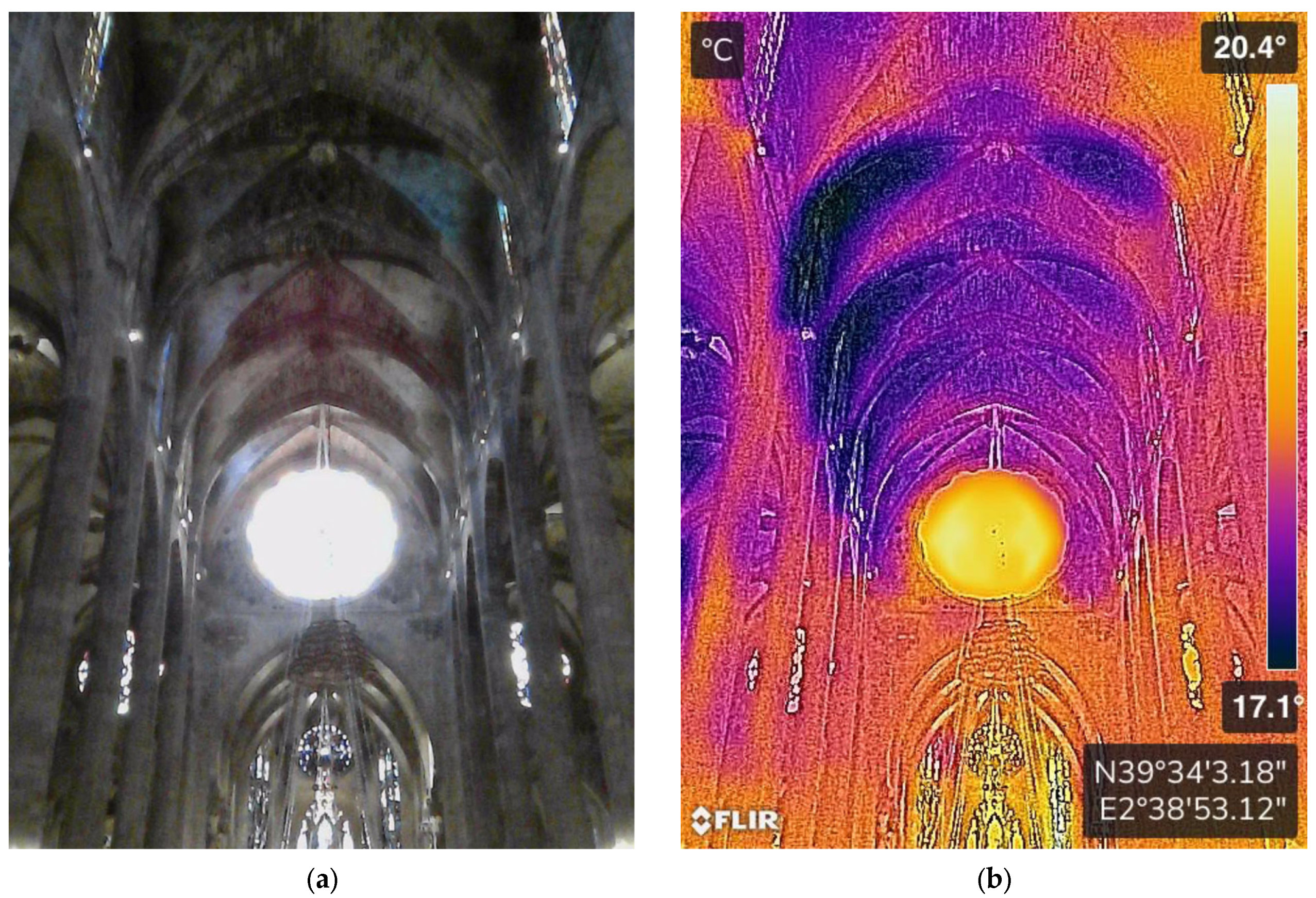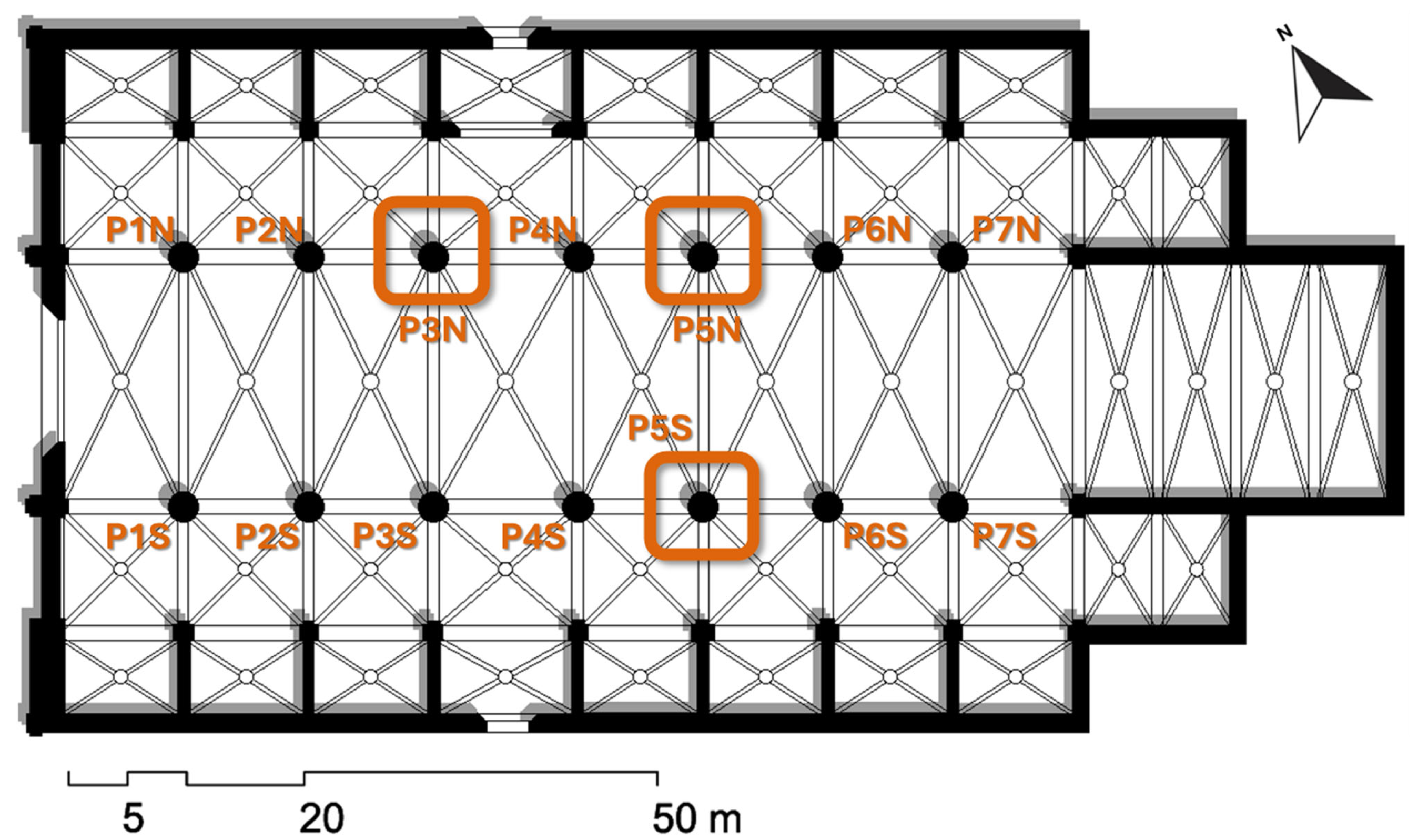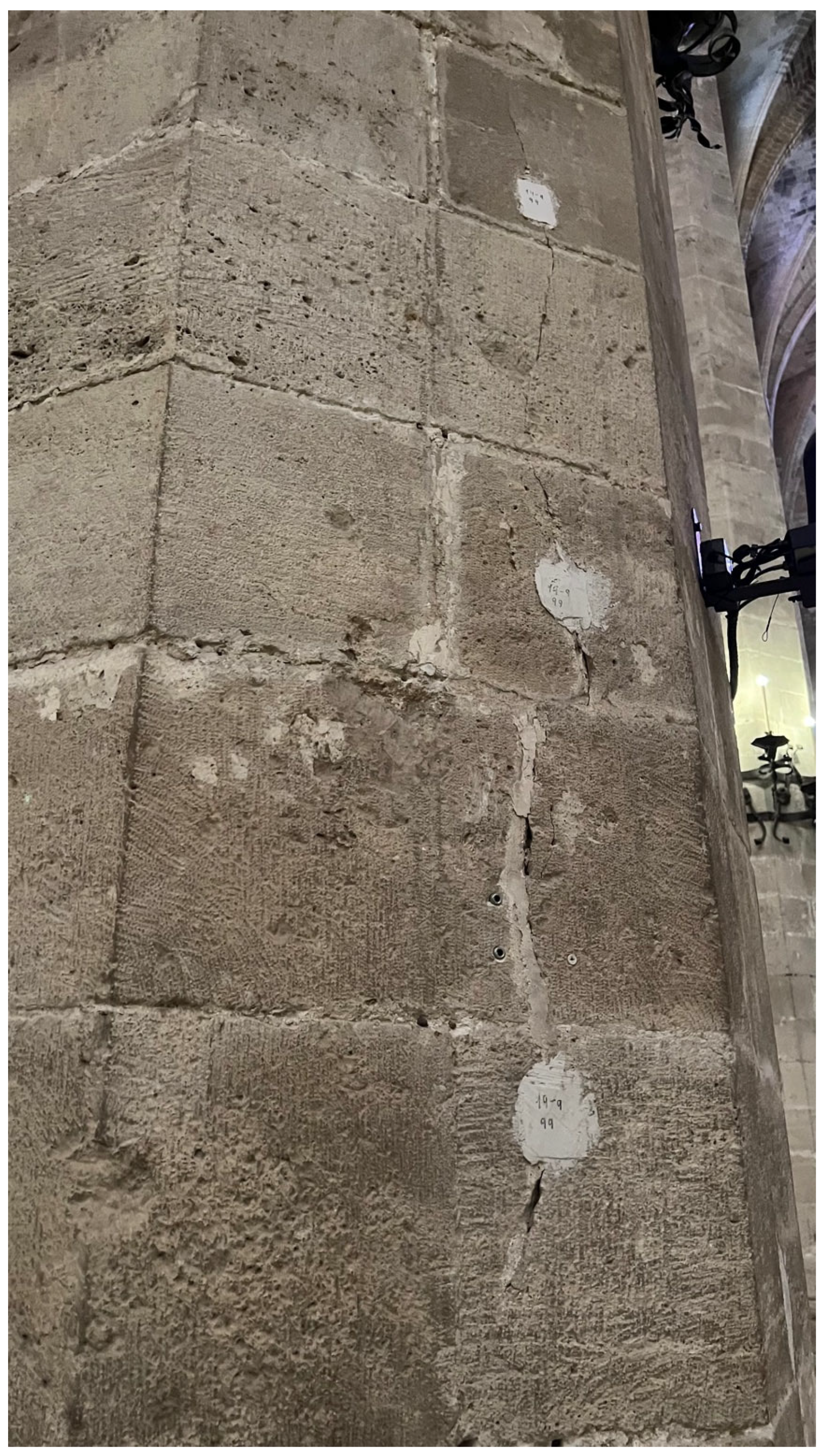1. Introduction
The Palma Cathedral, known as La Seu, stands as one of the crowning achievements of Mediterranean Gothic architecture and a key reference within Europe’s built heritage. Its construction began in 1229, following the Christian conquest of Madina Mayurqa by James I of Aragon—James I the Conqueror—[
1], and continued for several centuries, well into the 17th century [
2]. From its inception, the building served not only a liturgical and symbolic role, but also emerged as a territorial emblem of power [
3], dominating the Palma coastline with its monumental silhouette and orientation toward the bay (
Figure 1).
Architecturally, La Seu follows a basilican layout with three naves, a wide transept, and a polygonal apse. The central vault rises to 44 m, among the tallest in European Gothic architecture [
4,
5]. Verticality, lightness, and structural daring converge in the fourteen main piers of the nave—octagonal elements with no attached colonettes, standing 21 m tall with a diameter of only 1.5 m, yielding a slenderness ratio of 14:1. This surpasses the proportions found in major cathedrals such as Beauvais, Chartres, or Cologne [
6,
7,
8] (
Table 1).
Such extreme slenderness raises essential questions about material choice and structural performance [
9,
10]. Unlike other Gothic churches built in dense limestones or granites, Palma Cathedral relies on marés sandstone: a soft, porous, bioclastic calcarenite of marine origin [
11,
12,
13]. Despite its mechanical fragility, this regional stone enabled one of the boldest structural designs in Gothic Europe (
Figure 2).
The material that made this structural feat possible was marés stone, a marine-origin calcarenite abundant in Mallorca [
10], known for its workability, relatively low density, and high porosity [
12]. Marés sandstone is neither compact nor homogeneous; it is a living material—irregular and sensitive to environmental agents [
13]. Nonetheless, in expert hands and under a refined constructive logic, it supported one of the most daring structural ensembles in Gothic Christendom [
13]. The slenderness of La Seu’s piers depends not only on their geometric design [
14], but on a profound understanding of the physical and mechanical behavior of marés sandstone, combined with precise technical execution [
4].
Figure 3 presents a detail of structural elements characteristic of Gothic architecture [
15], all carved from marés stone. The image highlights the visual continuity of the material across structural and decorative components, as well as the chromatic variations associated [
12] with differential aging processes.
Several studies have addressed non-invasive diagnostic methods in heritage structures [
11,
16,
17], as well as the mechanical behavior and decay of calcareous stones in marine environments [
12,
18,
19]. However, few focus specifically on slender vertical elements or on highly porous materials like marés. This study builds on that background by applying diagnostic tools to a structurally unique scenario.
This study addresses a specific research question: How was it structurally feasible to construct the slender piers of Palma Cathedral using marés stone, a material with low mechanical resistance and high porosity?
To explore this, a non-invasive diagnostic campaign was carried out to assess the physical state of the stone, identify deterioration patterns, and understand how its properties relate to long-term structural behavior.
A comparative overview of the physical–mechanical properties of marés, compact limestone, and travertine—three calcareous stones commonly used in historical construction—is presented throughout the article. While the use of thermography and portable microscopy is not novel in itself, this study proposes their targeted application on a structurally extreme scenario: slender vertical piers made of an unusually fragile material.
By correlating decay mechanisms with location, geometry, and environmental exposure, the goal is to understand not only the pathology, but the logic behind this material-structural combination. Thermographic anomalies, fissure patterns, and localized deterioration were documented in situ and are illustrated in subsequent figuresand discussed in
Section 3.2,
Section 3.3 and
Section 3.4.
In doing so, the article contributes to the broader field of heritage conservation by linking diagnostic evidence with construction strategies in a unique case of material optimization under formal and mechanical constraints.
Beyond the identification of pathologies, this study interprets marés sandstone as a determining factor in the structural form of Palma Cathedral [
20]. Its fragility, paradoxically, enabled one of the boldest Gothic experiments through precise adaptation [
9] (
Figure 3). In the context of current concerns about sustainability and material adaptation, such historical insight remains highly relevant.
2. Materials and Methods
This research is based on an in situ material characterization and diagnostic campaign conducted on the stone masonry of Palma Cathedral, with particular attention to areas subject to heightened environmental and structural stress. The adopted methodology is grounded in a multi-technique, non-invasive approach, applied according to topological suitability criteria—that is, considering the degree of exposure, accessibility, and structural function of each element.
The objective was not merely to describe pathologies but to assess the current performance of marés sandstone as a load-bearing stone in a building that pushes the physical limits of its materials, particularly in the slender piers of the central nave. The study integrates techniques of varying scale and nature, from direct inspection to infrared thermography, with an emphasis on correlating empirical observation with technical data.
2.1. Visual Inspection and Photographic Documentation
A comprehensive technical survey was carried out on the cathedral’s exterior masonry, including perimeter walls, buttresses, flying buttresses, pinnacles, and base courses. The analytical approach followed a logic focused on identifying deterioration patterns linked to atmospheric agents, gravity, moisture, and salts, all of which have particularly aggressive effects on marés sandstone in coastal urban environments [
21]. The inspection aimed to detect both active and stabilized degradation processes, including surface disintegration, alveolization, material loss, cracking, crust formation (calcareous or biogenic), biodeterioration, and damage resulting from incompatible restoration interventions [
12].
Photographic documentation was structured using a direct photogrammetric methodology, incorporating physical scales, contextual references, and consistent angles to enable longitudinal comparisons and subsequent thermographic analysis. Inside the building, only structural elements showing evidence of active or historical damage were documented—such as vertical longitudinal fissures in the central nave piers—excluding surfaces with esthetic interventions or those considered structurally and visually stable.
2.2. Portable Microscopic Observation of the Stone Substrate
In representative sectors of the exterior masonry, portable digital optical microscopy was applied for in situ observation of the marés sandstone texture. This technique enabled close examination of granular morphology, distribution and aperture of intergranular pores, condition of carbonate cementation, presence of microfractures, differential dissolution, and early signs of biological colonization. Observation points were selected to include both original material in acceptable condition and zones exhibiting active alteration.
This technique was not applied to the interior surfaces, as it was deemed unnecessary from a pathological standpoint and methodologically inappropriate given the general state of conservation, the stable indoor thermal conditions, and the low incidence of active erosive processes in these areas.
2.3. Infrared Thermography
Infrared thermography was applied exclusively to the cathedral’s exterior masonry, as its physical principles—based on detecting minimal variations in surface thermal emission—require fluctuating environmental conditions to yield interpretable results. A mid-range FLIR thermal imaging camera was used, calibrated for daytime captures at different times of day, with priority given to periods of thermal transition (sunrise, midday, sunset).
The resulting thermograms enabled the identification of zones exhibiting differential cooling (associated with internal moisture accumulation or material disaggregation), areas with heterogeneous thermal behavior (potential material replacement or structural variation), and thermal loss lines compatible with active cracking or internal microfracturing. Particular attention was paid to the bases of vertical walls—ashlars in contact with the ground or adjacent to structural joints—and singular architectural elements such as pinnacles, which have reduced thermal mass and higher exposure.
Thermography was not initially conducted indoors due to the relatively uniform environmental conditions and limited thermal amplitude. However, this does not preclude its potential diagnostic value under controlled circumstances or during seasonal transitions.
2.4. Monitoring of Crack Markers and Structural Fissures
Several longitudinal cracks were observed in the structural piers of the central nave, some of which bore gypsum crack monitors from previous monitoring campaigns. Each monitor was documented in terms of quantity, position, state of preservation, aperture width, and—where legible—the installation date. These monitors represent a traditional passive control system, and their inclusion in this study allows for an evolutionary reading of certain structural pathologies.
No new markers were installed, nor were fissure gauges employed; however, the collected data provide a basis for assessing the relative stability of some lesions and support recommendations for more systematic future monitoring efforts.
2.5. Construction Context and Documentary Review
Finally, the study includes a critical review of bibliographic, technical, and graphic documentation concerning the historical construction of the Cathedral and the traditional use of marés stone in the Balearic architectural context. This contextual foundation enables the interpretation of marés sandstone not as a limited material choice, but as an optimized technological response capable of meeting the most demanding structural requirements of Mediterranean Gothic architecture. Particularly relevant is the understanding of marés sandstone as a structural stone in the design of extremely slender piers—an achievement that would not have been possible without an empirical, in-depth knowledge of its physical properties and behavior under load.
3. Results
3.1. Petrographic and Mechanical Characteristics of Marés Sandstone in Palma Cathedral
Marés stone is a detrital sedimentary rock classified as a calcarenite—that is, a calcareous sandstone composed primarily of bioclastic grains (fragments of marine organisms such as mollusks, red calcareous algae, corals, and foraminifera) bound together by calcium carbonate cement [
13]. It forms through the lithification of sediments deposited in shallow marine or coastal environments, mainly during the Miocene era [
11], and is widely distributed throughout the Balearic Islands, particularly in Mallorca and Menorca [
22].
Structurally, marés sandstone is characterized by a soft and highly porous matrix, with total porosity exceeding 35%, which makes it a lightweight and easily workable material. Its bulk density typically ranges between 1.5 and 1.8 g/cm
3, depending on its stratigraphic origin and the quarry of extraction [
13]. The constituent particles measure between 0.1 and 2 mm in diameter and are arranged heterogeneously, resulting in an open, granular, and anisotropic texture [
23].
The color of marés stone ranges from ochre to beige, light golden, or pinkish hues, influenced by the presence of iron oxides, residual organic matter, or secondary cementation [
20]. Over time, the surface may darken due to aging processes or prolonged exposure to atmospheric pollutants in urban or coastal environments [
18].
Mechanically, marés sandstone exhibits low to medium compressive strength (ranging from 2 to 12 MPa) and anisotropic behavior, with planes of weakness typically aligned with bedding layers or grain orientation [
12]. Its response to wetting and drying cycles is particularly critical: it readily absorbs water but is prone to swelling, localized dissolution, and salt crystallization—factors that render it highly susceptible to deterioration by hydric and saline weathering [
19].
This set of characteristics explains why marés sandstone was historically valued as a construction material in Mallorca—for its availability, lightness, and ease of carving—while also underscoring the need for careful conservation when used in exposed architectural contexts [
13]. The porous structure of marés stone is visible to the naked eye and is marked by substantial variability in pore size, shape, and distribution [
11]. Its workability has long been one of its greatest advantages in construction [
24], yet this same porosity makes it highly vulnerable to moisture absorption [
25], acid rain dissolution, salt crystallization, and biodeterioration (
Figure 4) [
21].
In situ observations identified several distinct textural types, both in original ashlars and in pieces that had been repaired or restored. The images obtained using a portable magnifying lens revealed wide intergranular voids, uncemented grain boundaries, and areas showing early signs of dissolution (
Figure 5). In some cases, fine particle accumulation or incipient biological colonization was observed in the most open pores.
Table 2 provides a comparative overview of the physical and mechanical properties of marés sandstone in relation to other calcareous stones commonly employed in historic architecture, such as compact limestone and travertine. The data are compiled from established technical sources and represent typical value ranges reported in the literature [
11,
12,
13,
22,
23,
24,
25,
26,
27].
The values listed for marés stone are approximate and can vary significantly depending on the quarry, degree of cementation, grain type, and age of extraction. Despite its intrinsically low strength, it was historically used for vertical structural elements thanks to its relative lightness and the precise geometric design of architectural components—such as the slender piers of the Cathedral—carefully dimensioned to optimize load distribution.
The high porosity of marés sandstone, combined with its absorbent capacity, helps explain many of the pathologies observed in the building, such as granular disintegration, salt crust formation, alveolization, and biological colonization [
12], which will be examined in the following section.
The use of marés sandstone in the supporting piers of Palma Cathedral is especially notable due to the extreme slenderness of these structural elements. The central piers rise to a height of 21 m and measure approximately 1.5 m in diameter at the base, resulting in a slenderness ratio of 14:1. These proportions are among the most daring in Gothic architecture and demand a precise distribution of loads and construction tolerances.
Figure 6 illustrates the formal geometry of these piers, showing both the octagonal plan and the elevation in relation to the central nave.
3.2. Alteration Processes in Marés Stone
Marés sandstone displays a vulnerability to various decay mechanisms typically triggered by environmental exposure in coastal settings: moisture retention, salt crystallization, biological activity, and atmospheric pollutants. These processes often act in combination, accelerating material loss and compromising structural elements. The following sections describe the main decay types observed.
Visual analysis of the stone masonry of Mallorca Cathedral has revealed a wide range of alteration processes affecting the ashlar blocks in different ways (
Figure 7).
As a porous and bioclastic lithological material, marés sandstone is particularly vulnerable to deterioration under aggressive environmental conditions such as those found in Palma de Mallorca: a humid to sub-humid climate, constant exposure to marine aerosols, sharp thermal contrasts across façades, and limited ventilation in certain areas of the structure [
26]. These factors, combined with the intrinsic physical properties of the material, give rise to a series of recurring pathological mechanisms observed in the stonework of the Cathedral [
28]. The main types of deterioration identified are detailed below [
12].
3.2.1. Surface or Granular Disintegration
Granular disintegration is the most frequently observed decay pattern affecting marés sandstone in Palma Cathedral. It manifests as surface powdering, flaking, or exfoliation of the outer stone layer, typically occurring in shaded, poorly ventilated, or moisture-retaining zones [
12,
24]. This deterioration is found on both exterior façades and interior structural elements, although more severe on south- and southeast-facing elevations, where exposure to marine aerosols and thermal gradients is greater [
26].
The process leads to the gradual loss of fine particles and weakening of the stone’s outer layer, reducing its mechanical cohesion and exposing the substrate to further decay. In early stages, it appears as a fine dusty film or superficial roughness; in advanced cases, it causes the detachment of crusts or laminae, particularly in areas with low carbonate cementation or high open porosity [
13,
18,
25].
Figure 7 illustrates a wall section exhibiting active granular disintegration, alongside alveolization and black crust formation. These phenomena are often interrelated: surface disintegration enhances water absorption, which in turn facilitates salt crystallization, microbial growth, and deeper material loss [
28,
29].
3.2.2. Alveolization and Localized Erosion
Alveolization refers to the formation of irregular concave cavities with rounded or undercut edges, frequently affecting the most exposed marés sandstone surfaces in Palma Cathedral. This form of erosion is especially common on windward façades and sculpted architectural details such as cornices, capitals, or decorative moldings [
12,
27].
The phenomenon leads to substantial volumetric loss, reducing the effective cross-section of affected blocks and undermining the integrity of sculptural or load-transmitting elements. Alveolization tends to advance from the surface inward, selectively affecting areas with weaker cementation or greater exposure to wet–dry and salt cycling conditions [
19,
30].
In several locations, cavity formation is accompanied by microbial colonization along cavity edges, further accelerating the decay process.
Figure 8 shows an advanced case of alveolization on the exterior masonry, where the geometry of the ashlar has been significantly altered. These forms of erosion often develop in tandem with granular disintegration and crust formation, contributing to a compounded deterioration scenario [
28].
3.2.3. Structural Cracking and Thermal Microcracking
Structural cracking was documented in several of the cathedral’s main load-bearing piers, particularly in the central nave (see
Section 3.4). These fissures exhibit predominantly vertical or slightly inclined trajectories, often crossing multiple ashlar blocks without following mortar joints. This pattern indicates deep structural causes, likely linked to historical settlement, vault thrust imbalances, or long-term deformation of the slender piers [
4,
14].
In addition to structural cracks, minor thermal microcracks were observed in exterior elements subject to strong hygrothermal gradients. These include flying buttresses, plinth zones, and corners of highly exposed façades. The marés sandstone’s anisotropic structure and high porosity make it particularly sensitive to cyclic expansion and contraction under fluctuating environmental conditions [
16,
19].
Cracks—whether structural or thermally induced—compromise the cohesion of masonry units, create entry points for water and salts, and promote microbial colonization. In advanced cases, they may lead to detachment or fragmentation of blocks. Several fissures show long-standing gypsum markers installed in previous monitoring campaigns, some of which exhibit partial fracturing, suggesting historical but stabilized movement [
4,
31,
32].
While most fissures currently appear dormant, their presence in elements with extreme slenderness ratios demands systematic, instrumented monitoring to detect any future displacements under environmental or dynamic loading [
14].
3.2.4. Formation of Surface Crusts (Calcareous and Biogenic)
Surface crusts were identified on both exterior and interior masonry surfaces, primarily in areas shielded from rainfall such as cornices, vault intradoses, and upper wall sections. These crusts can be classified into two main types: calcareous and biogenic.
Calcareous crusts form through cycles of dissolution and recrystallization of calcium carbonate, resulting in a hardened surface layer that inhibits breathability. While they may provide temporary protection, these crusts trap moisture beneath the surface, creating favorable conditions for internal decay and disaggregation [
18].
Biogenic or black crusts are more frequent in humid or poorly ventilated areas. They result from the accumulation of atmospheric pollutants, dust, and organic matter—often associated with the presence of fungi, algae, or bacteria [
29,
32]. In Palma Cathedral, these deposits are particularly common in shaded zones of the southeast façade and upper interior vaults.
Both types of crusts alter the moisture transfer dynamics of the stone and accelerate decay by promoting capillary retention, salt crystallization, and sub-efflorescence.
Figure 6 shows a combination of black crusts and granular disintegration on a lower wall section, illustrating the interaction between surface sealing and deeper material loss.
3.2.5. Incompatible Interventions and Restoration Materials
Several sectors of the cathedral’s masonry show signs of deterioration caused by past restoration efforts involving materials incompatible with the original marés sandstone. These include repairs using cement-based mortars, non-porous stone replacements, or surface coatings that obstruct vapor diffusion.
Cementitious mortars—denser and less permeable than marés—alter the natural moisture transfer mechanisms of the masonry, leading to the accumulation of humidity and salts in adjacent stone blocks. This mismatch contributes to accelerated decay in nearby marés units through stress concentration and differential expansion [
12,
18].
Similarly, some replacement blocks exhibit markedly different textures, porosities, and thermal behaviors compared to the original fabric. These differences are often undetectable in visual inspection but become evident through infrared thermography, which reveals anomalous heat retention or dissipation patterns (see
Section 3.3) [
16,
17].
Partial renders or consolidants applied to exposed areas without respecting the material’s capillary dynamics have also caused localized blistering, microcracking, or detachment. These interventions, although well-intentioned, underscore the importance of diagnostic-based conservation strategies rooted in material compatibility [
12].
The identification of these pathologies reinforces the need for restoration criteria that are reversible, breathable, and mechanically and chemically compatible with marés sandstone—particularly given its high porosity and thermal sensitivity [
24,
25].
3.3. Thermographic Analysis
Infrared thermography does not replace visual inspection or material analysis [
33], but it serves as a highly valuable complementary diagnostic tool—especially effective in detecting incipient deterioration processes, moisture retention zones, or internal discontinuities not visible to the naked eye [
34].
Applied to the masonry of Palma Cathedral, infrared thermography enabled the detection and characterization of pathologically relevant areas not always apparent through visual observation [
16]. In a stone like marés sandstone —highly porous and thermally anisotropic—thermal response variations can indicate changes in density, moisture content, internal cohesion, and the presence of fissures.
3.3.1. Thermal Behavior of Marés Sandstone: Principles and Interpretation
Marés sandstone exhibits low thermal inertia and high open porosity, making it particularly sensitive to heat flow and moisture presence. Its heat capacity is low when dry but changes significantly when saturated. This leads to
Moist areas retaining heat during the day and cooling more rapidly at night due to evaporation;
Cracks or disaggregations that generate thermal discontinuities, visible as cold lines or distinct contrasts;
Restored areas with mortars or stones of differing thermal density displaying divergent behavior despite chromatic similarity.
Such thermal patterns enable inference of internal alterations, even in the absence of visible surface damage.
3.3.2. Capture Conditions and Instrument Calibration
The thermographic campaign focused exclusively on exterior walls, where direct solar exposure and natural ventilation create differentiated thermal conditions. A calibrated FLIR thermal camera was used with the following constant parameters:
Emissivity: 0.95;
Measurement distance: 1 m;
Reflected temperature: 22 °C;
Atmospheric temperature: 20 °C;
Relative humidity: 50%;
Atmospheric transmission: 0.99;
External optical temperature: 25 °C;
External optical transmission: 0.8.
Image acquisition prioritized the cooling periods (late afternoon/shaded conditions), where thermal contrasts between wet and dry zones are more pronounced. Constant calibration ensured homogeneity across the image set.
3.3.3. Thermal Results and Observed Patterns
Thermograms obtained from walls and structural elements (especially buttresses) revealed a set of distinct thermal behaviors [
35], interpreted as indicators of potential material deterioration:
Vertical thermal gradients in exterior buttresses and piers, with pronounced cooling at the base.
Figure 9 shows a thermal difference of over 6 °C between the base (7.8 °C) and the upper section (14.0 °C), indicative of rising damp or moisture accumulation in the lower wall sections. This temperature contrast, recorded without direct solar radiation, suggests retained capillary moisture likely due to the marés’ active porosity and lack of a horizontal damp-proof course.
Localized cold spots with no relation to joints or construction geometry. As shown in
Figure 10, some areas display temperatures over 5 °C lower than their immediate surroundings—interpreted as retained moisture or internal stone disaggregation.
Thermal contrasts between adjacent ashlar blocks, revealing incompatible repairs or stone replacements.
Figure 11 shows blocks with a thermal response of 20.3 °C—deviating from the dominant wall pattern (15–17 °C)—suggesting differences in density, porosity, or surface treatment.
Generalized thermal heterogeneity, attributable to accumulated microstructural differences due to differential disaggregation.
Figure 12 displays an irregular thermal pattern unrelated to geometry, suggesting progressive, uneven loss of cohesion among stone units.
3.3.4. Diagnostic Interpretation and Visual Correlation
In all analyzed cases, thermal anomalies correlate with visual observations, known pathologies, or previously hypothesized issues. Thermography’s ability to detect
Invisible active moisture,
Incipient structural damage,
Hidden incompatible materials
makes it a valuable tool for preventive diagnosis—especially in situations where surface signs of deterioration have not yet manifested.
The correlation between thermographic data and in situ observations is strong: in most instances, thermal anomalies spatially coincide with visible damage (disintegration, cracking, material substitutions), and in others, they help anticipate areas at risk.
3.3.5. Future Applications in Preventive Conservation
Thermography should be integrated into routine monitoring campaigns—particularly for materials like marés stone, whose thermal behavior is closely tied to their degradation [
36]. As demonstrated above, thermography is well-suited to [
36]
Generate vulnerability maps of heterogeneous masonry;
Confirm visually formulated diagnostic hypotheses;
Identify incompatible restoration materials.
Due to its sensitivity to internal moisture, thermography can also serve as an indirect indicator of progressive disaggregation—particularly useful for porous stones exposed to intense thermal cycles, as is common in Palma’s climate. Its systematic use can help
Establish seasonal thermal baselines,
Assess the effectiveness of interventions,
Prioritize critical areas for structural studies or laboratory testing.
In the case of Palma Cathedral, the results justify incorporating thermography as a diagnostic tool in future monitoring campaigns, particularly for plinths, buttresses, material replacements, and visually inaccessible zones.
3.3.6. Indoor Thermographic Analysis
In addition to the exterior thermographic survey, an indoor infrared analysis was carried out to assess the thermal behavior of the structural elements located in the southern section of the central nave, as well as the eastern vault system. The inspection was performed using a FLIR thermal imaging device under stable environmental conditions: ambient temperature 20 °C, reflected apparent temperature 22 °C, relative humidity 50%, and an emissivity coefficient of 0.95. The measurement distance was approximately 1 m, with minimal thermal interference from direct solar radiation or strong air currents.
The thermographic results showed a uniform temperature distribution across the stone surfaces, with recorded values ranging from 16.7 °C to 20.4 °C. No cold anomalies, vertical thermal gradients, or significant discontinuities were detected in the surveyed masonry. These findings suggest the absence of active moisture ingress, internal disaggregation, or incompatible repair materials in the interior structural fabric.
Figure 13 and
Figure 14 present a selection of the indoor thermograms. In contrast with the exterior diagnostic campaign—where material heterogeneities and thermal anomalies were more evident—the interior images reflect a consistent and stable thermal behavior. These results support the interpretation of interior piers and vaults as structurally sound and thermally homogeneous under current environmental conditions.
The results of the indoor thermographic campaign provide a baseline for future preventive conservation strategies. Although no thermal anomalies were detected under the conditions of this survey, the data suggest that seasonal monitoring—particularly during periods of high humidity or sharp temperature variation—could be useful in identifying early-stage deterioration. Incorporating periodic infrared inspections into a preventive maintenance protocol would allow custodians to track changes in thermal behavior and detect subtle moisture ingress or hidden structural discontinuities over time. Given the cathedral’s size and complexity, these methods are especially suitable for non-invasive long-term tracking of interior piers and vault systems.
3.4. Observation of Cracks and Monitoring Markers
During the interior visual inspection, several longitudinal fissures were documented in the central nave’s main structural piers [
14], specifically affecting piers P3N, P5N, and P5S (
Figure 15). These vertical cracks run across multiple ashlar blocks with continuity and do not follow mortar joints—indicating a structural rather than superficial origin. In some cases, the fissures extend over 3.5 m in height, from the base of the pier toward the springing of the vaults.
The floor plan shows all vertical supports, including both nave piers and aisle columns. However, the “fourteen piers” referenced in this study refer specifically to the four on each side of the central nave that support the main vaults—those analyzed in the structural and diagnostic campaign.
Pier P5S presents the most visible damage, with a vertical crack along its north face. This condition is illustrated in
Figure 16, which also shows the remnants of a previous instrumentation system: small dowel holes or metal anchor points once used to fix structural monitoring devices. These elements suggest that Pier P5S had been subject to technical surveillance in the past, although no active system remains in place today. The presence of such anchors provides material evidence of early concern regarding structural risk [
4,
14].
Additional fissures were observed on Piers P3N and P5N. On P3N, a gypsum crack monitor installed in 1999 is partially fractured along a diagonal line, implying minor movement occurred shortly after installation. Two other markers on this same pier remain intact, as do two more on P5N and one on P4N. The preservation of these markers indicates that no measurable displacements have occurred since their installation, though their analog nature limits the accuracy of such assessment [
4,
30].
These locations are documented in
Figure 14, a ground plan of the central nave showing the fourteen primary piers of the structure (P1–P7, north and south sides). Orange frames highlight the piers where fissures were recorded: P3N, P5N, and P5S. This spatial reference allows a clearer understanding of the distribution of structural vulnerabilities and supports future monitoring design.
Although interior thermography was not initially conducted—due to assumptions of thermal uniformity and limited environmental contrast [
16]—the identification of structural fissures in key load-bearing elements justifies a reconsideration. Targeted thermographic analysis during seasonal transitions (e.g., spring and autumn) could reveal moisture ingress or internal disaggregation not currently visible, especially given the thermal sensitivity of marés sandstone [
16,
19,
36].
Given the exceptional slenderness of these piers (height-to-diameter ratio of 14:1) [
4], even stabilized fissures must be treated as critical. It is therefore recommended to reinstate a structural monitoring protocol using contemporary, high-precision tools such as mechanical gauges, digital displacement sensors, or 3D laser scanning. This is especially important in Pier P5S, located at a central bay where multiple vault thrusts converge, increasing its exposure to cumulative stress [
14].
4. Discussion
The diagnostic campaign carried out in Palma Cathedral provides a detailed insight into the material performance of marés sandstone under structurally demanding conditions. The analysis focused particularly on the fourteen octagonal piers of the central nave—elements that, due to their exceptional slenderness ratio (14:1), push the limits of what is mechanically feasible using a porous calcarenite. The study confirms that their construction was only possible through a combination of empirical knowledge, precise geometric control, and local adaptation.
Visual inspection, supported by microscopy and thermography, revealed deterioration processes typical of soft calcareous stones in marine environments: granular disintegration, alveolization, salt crystallization, biological colonization, and structural fissures. These pathologies are not distributed randomly but follow identifiable environmental and geometric patterns. Most affected areas are located on the south and southeast façades, which face stronger solar exposure and prevailing sea winds—factors that exacerbate hygrothermal cycling and salt mobility (
Figure 6,
Figure 7,
Figure 8 and
Figure 9).
In contrast to more compact materials used in cathedrals like Chartres or Cologne [
7,
8], marés sandstone exhibits open porosity rates exceeding 30%, bulk densities as low as 1.5 g/cm
3, and compressive strength values ranging between 2 and 12 MPa (
Table 2) [
12,
13,
23]. These values, although unfavorable from a structural standpoint, are offset in Palma Cathedral by the relatively low self-weight of the material and the precise load distribution achieved by the vaulting system [
14].
The vertical fissures observed in piers P3N, P5N, and P5S (see
Figure 14) indicate localized structural strain rather than widespread instability. The presence of long-standing gypsum markers, some dating to 1999, suggests partial historic movement that has since stabilized. Thermographic patterns—particularly vertical cold gradients and heterogeneous thermal responses—corroborate these findings and highlight zones of retained moisture, internal discontinuities, and material incompatibility (
Figure 8,
Figure 9,
Figure 10 and
Figure 11).
Comparable diagnostic campaigns have been carried out in limestone cathedrals such as Beauvais [
8] and Mallorca itself [
16]. However, most focus on vaults or façades, not vertical piers made of marine calcarenite. This makes the present case particularly instructive, as it addresses the performance of a porous, anisotropic stone in elements subjected to high vertical loads and slender geometry.
Rather than focusing solely on damage, this study interprets marés as an active agent in the architectural design. The successful use of this fragile material to achieve such formal boldness reflects not only craftsmanship but a vernacular logic of material optimization. This reinforces the idea that Mediterranean Gothic construction, often undervalued in favor of Northern models, developed regionally adapted structural strategies using locally available resources.
From a conservation perspective, the findings validate the need for systematic, non-invasive diagnostics as a baseline for long-term monitoring. In particular, the study underscores the importance of thermographic imaging in identifying early signs of disaggregation and moisture retention—critical parameters for porous stones exposed to marine climates [
16,
17,
36].
While the methodology employed is not new, its application to a structurally extreme scenario provides valuable insights into how historical builders managed structural risk through material knowledge rather than mechanical overdimensioning. The Palma Cathedral thus becomes a test case for how empirical design decisions can be read through contemporary diagnostic tools.
While this study provides a detailed assessment of marés stone behavior in a structurally demanding context, it is not without limitations. All observations and measurements are based on non-invasive surface techniques, without petrographic sampling or mechanical load testing. No finite element modeling or in-depth structural simulation was conducted. As such, the internal stress distribution within the piers remains inferred rather than measured.
Future research could integrate digital deformation sensors, 3D laser scanning, and structural monitoring over time to quantify displacements and verify long-term stability. Comparative studies in other Mediterranean churches built with marés or similar calcarenites would also help determine whether the findings from Palma Cathedral reflect a unique case or a broader regional strategy of material optimization.
In the context of sustainable architecture, the renewed interest in locally sourced, low-impact materials parallels the historical use of marés. Its environmental adaptability, minimal transport footprint, and compatibility with reversible construction practices align with current strategies in circular architecture. However, its durability must be re-evaluated in light of climate change and urban pollution.
In response to the research question posed in the introduction—whether it was structurally feasible to construct slender Gothic piers using marés stone—the diagnostic results indicate that this was possible only through a combination of empirical knowledge, precise construction practices, and favorable material geometry. While marés provided workability and lightness, its low mechanical resistance required strict control and ongoing maintenance. The current state of the structure suggests that the solution was bold but not without long-term vulnerabilities.
While the exceptional slenderness of Palma Cathedral’s piers is architecturally remarkable, it does not demonstrate the intrinsic structural adequacy of marés sandstone. On the contrary, the diagnostic evidence—including fissures and material disaggregation—suggests that the long-term behavior of marés under vertical stress is far from ideal. The successful construction of the piers should thus be understood as the result of careful geometric control and extraordinary craftsmanship, rather than material suitability. In this context, the use of marés appears to be a pragmatic choice conditioned by local availability, rather than a structurally optimal decision.
5. Conclusions
This study explored the structural viability of marés sandstone in one of the most formally ambitious Gothic churches in Europe: Palma Cathedral. Through a non-invasive diagnostic campaign combining visual inspection, portable microscopy, and infrared thermography, it was possible to evaluate how a porous, mechanically weak material was used to construct vertical piers with exceptional slenderness ratios.
The findings confirm that the stability of these piers relies not on the inherent strength of marés stone, but on its precise geometric deployment, low self-weight, and the accumulated empirical knowledge of medieval builders. While deterioration processes such as granular disintegration, alveolization, and salt-induced decay are present—especially on the south and southeast façades—they appear to be locally distributed and structurally contained.
Infrared thermography proved effective in identifying internal moisture retention, thermally incompatible repairs, and hidden discontinuities in the masonry. The correlation between thermal anomalies and visible pathologies reinforces the value of this tool in preventive conservation. In particular, vertical thermal gradients observed in lower ashlar zones support the hypothesis of capillary moisture rise in contact areas.
The presence of long-standing structural fissures in piers P3N, P5N, and P5S—monitored intermittently since the late 1990s—highlights the need for updated instrumentation and regular structural tracking. However, no current signs of displacement or active deformation were detected.
From a heritage perspective, this case demonstrates how material fragility can coexist with structural sophistication when informed by empirical adaptation. While marés sandstone cannot be considered a robust structural material by conventional standards (
Table 2), its lightness, workability, and regional availability made it an optimized choice in its historical context.
The methodology applied here is not novel in isolation, but its use in a structurally extreme setting offers insights into how vernacular materials were intelligently employed to meet architectural challenges. The Palma Cathedral thus emerges not only as a spiritual and symbolic landmark but also as a built demonstration of material logic under constraint—a case that invites further interdisciplinary study.
